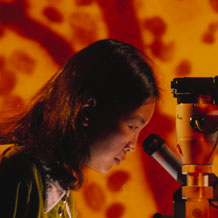
What it is:
High blood-sugar levels from diabetes can damage blood vessels in your retina, the nerve layer of tissue at the back of your eye. This damage is called diabetic retinopathy.
What You Need To Do:
Schedule an eye exam at least once a year and maintain control of your blood sugar if you have diabetes.
Why It’s Important:
Early diagnosis and treatment can prevent vision loss.
In-Depth Information:
| Symptoms | Treatment | Tests/Diagnosis | Causes/Risk Factors | All |
Symptoms
Often there are no symptoms in the early stages of diabetic retinopathy. Don't wait for symptoms to have a comprehensive eye exam.
If you suddenly see a few specks or spots floating in your vision, this may indicate proliferative diabetic retinopathy, the growth of abnormal new blood vessels on your retina and optic nerve.
Blurred vision may occur when the macula - the small area at the center of the retina - swells from fluid leaking from retinal blood vessels.
Rapid changes in blood sugar can cause temporary blurring of vision in both eyes even if retinopathy is not present.
You should have your eyes checked promptly if you experience changes in your vision that last more than a few days and are not associated with a change in blood sugar.
Treatment
Prevention is the best treatment for diabetic retinopathy. Strict control of your blood sugar will significantly reduce the long-term risk of vision loss.
If retinopathy has caused macular edema laser surgery may prevent further loss of vision. The macula is the small area in the center of the retina that allows us to see fine details clearly. The laser will be focused on the damaged retina near the macula to decrease the fluid leakage.
If abnormal blood vessels have grown on the retina (proliferative diabetic retinopathy), laser surgery can be effective in shrinking those vessels and preventing them from growing in the future. Multiple laser treatments over time are sometimes necessary. Laser surgery does not cure diabetic retinopathy and does not always prevent further loss of vision.
If there is advanced damage to the eye because of retinopathy, a microsurgery called vitrectomy may help. During this procedure, your ophthalmologist (Eye M.D.) can remove eye fluid that has become filled with blood and replace it with a clear fluid.
Tests/Diagnosis
A medical eye examination is the best way to detect changes inside your eye. An ophthalmologist can often diagnose and treat serious retinopathy before you are aware of any vision problems. The doctor dilates your pupil and looks inside of the eye with an ophthalmoscope.
If your Eye M.D. finds diabetic retinopathy, he or she may order color photographs of the retina. Your doctor may also order a special test called fluorescein angiography to find out if you need treatment. In this test, a dye is injected into your arm and photos of your eye are taken to detect where fluid is leaking.
If you have diabetes and you are 29 years old or younger, see an ophthalmologist (Eye M.D.) within five years of your diagnosis. If you are 30 years old or older, see an Eye M.D. within a few months of your diagnosis.
Pregnant women with diabetes should schedule an appointment in the first trimester, because retinopathy can progress quickly during pregnancy.
Causes/Risk Factors
There are two types of diabetic retinopathy: nonproliferative diabetic retinopathy (NPDR) and proliferative diabetic retinopathy (PDR).
NPDR, also known as background retinopathy, is an early stage of diabetic retinopathy. In this stage, tiny blood vessels within the retina leak blood or fluid. The leaking fluid causes the retina to swell or to form deposits.
Many people with diabetes have mild NPDR, which usually does not affect their vision. Vision is affected by problems with the macula, a small area in the center of the retina that allows us to see fine details clearly. The macula can either swell (edema) or have its blood supply cut off (ischemia).
PDR is present when abnormal new blood vessels grow on the surface of the retina or optic nerve. These new vessels can bleed into the gel-like substance that fills the center of the eye (the vitreous) and can cause temporary vision loss.
PDR can cause wrinkling or pulling of the retina, which results in visual distortion or vision loss. Occasionally, PDR can cause abnormal blood vessels to grow on the iris (the colored part of the eye) and in the drain where fluid leaves the eye. This blocks the normal flow of fluid out of the eye and can result in neovascular glaucoma, a severe eye disease that causes damage to the optic nerve.


 Share with a friend
Share with a friend



